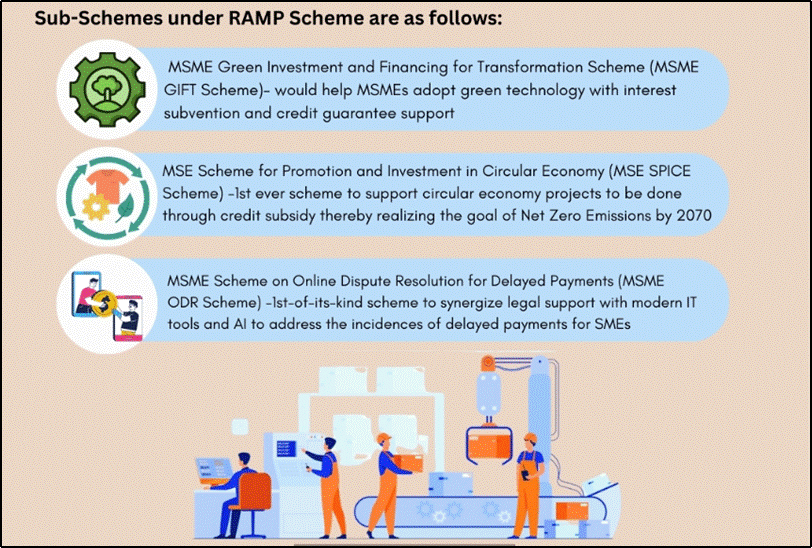Raising and Accelerating MSME Performance (RAMP) Scheme
Recently, the Raising and Accelerating MSME Performance (RAMP) scheme was in the news.
- Aim- It aims to enhance MSME capacity and coverage by fostering innovation, improving processes, enhancing market access, promoting greening initiatives, and supporting women-owned enterprises.
- Nodal agency- Ministry of Micro, Small and Medium Enterprises.
- Launched in - 2022.
- Duration- 5 years (2021-22 to 2025-26).
- Participant states- All States and UTs, except Delhi, have shown interest in participating in RAMP.
- Funding- It is a World Bank-supported Central Sector Scheme.
- Eligibility- The MSME should be registered under the Micro, Small, and Medium Enterprises Development (MSMED) Act, 2006.
- The MSME should have a valid Udyog Aadhaar Number (UAN).
- Objectives-
- Accelerating Centre- State collaboration in MSME promotion and development.
- Enhancing effectiveness of existing MoMSME schemes for technology upgradation.
- Strengthening Receivable Financing Market for MSMEs and enhancing effectiveness of Credit Guarantee Trust for Micro & Small Enterprises (CGTMSE), and promoting guarantee for greening initiatives of MSEs, and women owned MSEs.
- Reducing incidence of delayed payments to MSEs

References
- PIB | RAMP scheme
- INVEST India | RAMP scheme
Rural Youth Employment Report, 2024
The ‘State of Rural Youth Employment Report 2024’ was released recently.
- Released by - Development Intelligence Unit, a joint initiative by Transform Rural India and Sambodhi Research, and the Global Development Incubator.
- For the report 5169 rural ‘Opportunity Youth’ from 21 states across India between 18-35 years of age were interviewed.
Opportunity Youth are youth who are active and inactive, unemployed, underemployed, and out of school/education / skilling.
Key Findings of the report
- Age group - Among the respondents, 26.6% were aged between 18-25 years and the remaining 73.4% were aged between 26-35 years.
- Working population
- Male - Of these, just over half of the male respondents aged 18-25 years were currently working.
- Among older male youth aged between 26-35 years, nearly 85% said they were engaged in paid work, and nearly 10% said they used to work but were currently unemployed.
- Female - In contrast, only a fourth of female respondents in the same age group said they were currently engaged in paid work.
- By contrast, among female youth in the same age group only 40% said they were currently working, a fourth reported having dropped out of the workforce, and a third reported never having worked for pay.
- According to the Directorate General of Labour, Ministry of Labour and Employment 32.8% females aged 15 years and above in India are participating in the labor force, as compared to 77.2% males.
- The Female Labour Force Participation Rate (LFPR) in the age group 15-59 years is 35.6%, as compared to 81.8% male.
- Primary sources of income- Nearly half of rural youth rely on agriculture, followed by wage labor and retail trade.
- Higher Job dissatisfaction - A significant majority between 70-85% of currently employed rural youth are looking to change their jobs.
- Preferred employment types - Many youths prefer small businesses (manufacturing, retail, trading) or salaried jobs in public and private sectors.
- Salaried jobs across the public and private sectors were the clear second preference, with teaching, clerical work, and working in a factory being top job preferences across gender and age group.
- Younger male youth prefer government or private sector jobs, and women prefer government jobs.
- Support needs- For starting businesses, 90% of male and 50% of female respondents need support accessing seed capital, and 10% need full training courses.
- Location preferences- Over 60% of male and 70% of female respondents prefer to work in or near their villages, even at lower incomes.
- Employment rates- Higher employment rates for males compared to females in both the 18-25 and 26-35 age brackets.
References
- The Indian Express | Rural Youth Employment report 2024
- Financial Express | Rural Youth Employment report 2024
Self-Reliance in P&K fertilizer
Recently, the government has been committed to making the country self-reliant in the production of Phosphorus and Potassium (P&K) fertilizers and is taking several steps towards this goal.
- Components- Potash (K) and phosphate (P) are essential for increasing the production of foodgrains and other agricultural products, along with nitrogen (N).
- Ideal ratio- A NPK ratio of 4:2:1 is considered ideal and accepted for macro-level monitoring of plant nutrient consumption for the country.
- Decontrol of P&K Fertilizers in 1992- It allowed market forces to dictate prices.
The PV Narasimha Rao government removed subsidies on non-urea fertilizers (P and K) but retained control and subsidy on urea.
- Production- Currently, India's fertilizer production is 42-45 million tonnes while imports are around 18 million tonnes.
- Imports- During 2021-22, the total value of fertilizer imports, inclusive of inputs used in domestic production, was 24.3 billion dollars.
- Current status on Imports of India
- Potash (K) - Depends entirely on imports coming mostly from Belarus, Canada, Russia, Israel, and Jordan.
- Import - Import dependence is almost 80%-90%, with imports coming mainly from China, Saudi, Morocco, Jordan and Egypt.
- Auctioning of blocks- The government has enacted laws to auction critical mineral blocks like potash and phosphate for exploration and processing in India.
|
Types of P&K Fertilizers
|
- Diammonium Phosphate (DAP): Widely used phosphorus fertilizer.
- Muriate of Potash (MOP): Key source of potassium.
- NPK Complex Fertilizers: Combination of nitrogen, phosphorus, and potassium in varying ratios.
- Single Super Phosphate (SSP): Source of phosphorus.
|
Government Steps for Self-Reliance in Fertilizer Production
- Permissions granted to fertilizer companies to increase manufacturing capacity under Nutrient Based Subsidy (NBS).
- The policy provides a fixed subsidy on each grade of subsidized P&K fertilizers based on nutrient content.
- New Investment Policy (NIP) to facilitate fresh investments and set up 6 new urea units.
- Promotion of Organic Fertilizers under the GOBARdhan initiative.
- The use of liquid nano DAP (diammonium phosphate) and nano urea is being promoted to reduce imports.
References
- PIB | Self-Reliance in P&K fertilizer
- Deccan Herald | Self-reliance in fertilizers
Homo floresiensis
New clues emerge on the evolutionary origins of extinct hobbits that once lived on Indonesia’s Flores island.
- Homo floresiensis - It is an extinct species of small archaic human that inhabited the Island of Flores, Indonesia.
- They are also called Flores men or the ‘hobbits’ of Indonesia’s Flores island.
- Homo floresiensis fossils were first discovered in 2003.
- Characteristics - They were about 100 centimetres (3 feet 6 inches tall) tall and 30 Kg weight.

- Body Size - Body size had reduced from large-bodied Asian Homo erectus sometime between 1 and 0.7 million years ago due to island dwarfism.
Island dwarfism is an evolutionary process that results from long-term isolation on a small island with limited food resources and a lack of predators.
- Appearance - Tiny brains, large teeth for their small size, shrugged-forward shoulders, no chins, receding foreheads, and relatively large feet due to their short legs.
- Tools - Made and used stone tools and may have used fire.
- Hunting - Hunted small elephants and large rodents, and coped with predators such as giant Komodo dragons.
- Recent findings - Discovery of 3 hominin fossils dating to 700,000 years from Mata Menge in central Flores.
- Most of the Homo floresiensis fossils are found at Liang Bua cave in Indonesia.
- Theories of their origin
- Theory 1 - Homo floresiensis was a dwarfed descendant of early Asian Homo erectus.
- Homo erectus, extinct species may have lived between 100,000 and 1.6 million years ago.
- Theory 2 - Homo floresiensis is a descendant of a more ancient hominin from Africa like Homo habilis or the famous ‘Lucy’ (Australopithecus afarensis).
References
- DownToEarth | New clues on Homo floresiensis
- Smithsonian | Homo floresiensis
Waqf board
The recently introduced Waqf (Amendment) Bill governing Waqf boards has proposed far-reaching changes, ensuring the representation of Muslim women and non-Muslims in such bodies.
Waqf
- Under the Waqf Act of 1954, a Waqf refers to a property dedicated in the name of God for religious and charitable purposes.
- Legally, it is the permanent dedication by a Muslim of any movable or immovable property for purposes recognized by Muslim law as pious, religious, or charitable.
- A Waqf can be established through a deed or instrument, or a property can be considered a Waqf if it has been used for religious or charitable purposes over a long period.
- The proceeds from Waqf typically fund educational institutions, graveyards, mosques, and shelter homes.
- Once a property is designated as a Waqf, it becomes non-transferable and is detained perpetually as a charitable act toward God, essentially transferring ownership to God.
- Waqfs can be either public, serving charitable ends, or private, benefiting the property owner’s direct descendants.
- To create a Waqf, one must be of sound mind and hold valid ownership of the property.
- Interestingly, the creator of a Waqf, known as the Waqif, does not have to be a Muslim, as long as they profess belief in Islamic principles.
Waqf board
- A Waqf board is a legal entity capable of acquiring, holding, and transferring property.
- It can sue and be sued in court.
- Members - Each state has a Waqf Board led by a chairperson, including
o Nominees from the state government,
o Muslim legislators,
o Parliamentarians,
o Members of the state bar council,
o Islamic scholars,
o And mutawalis (managers) of waqfs with an annual income of rs 1 Administration - lakh and above.
- The Waqf Board administers Waqf properties, recovers lost properties, and sanctions the transfer of immovable Waqf properties through sale, gift, mortgage, exchange, or lease.
- Voting - At least two-thirds of the board members voting in favour of the transaction.
- The board appoints custodians to ensure the Waqf and its revenue are used for their designated purposes.
- Central Waaf Council (CWC) - The Central Waqf Council (CWC), established in 1964, oversees and advises state-level Waqf Boards across India.
References
- The Print | The Waqf (Amendment) Bill
- Business Standard | What is a Waqf?

